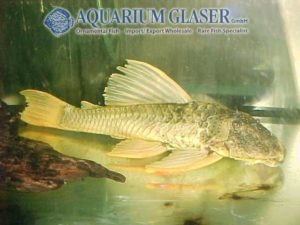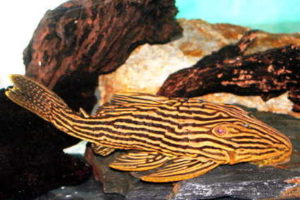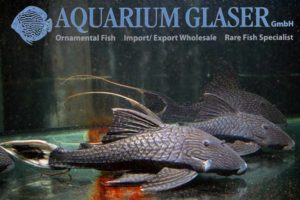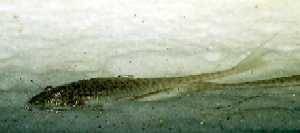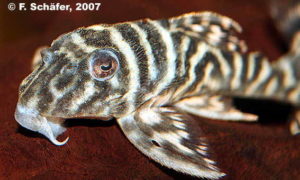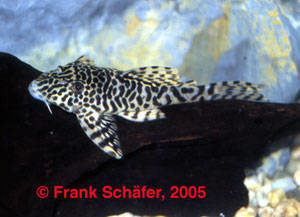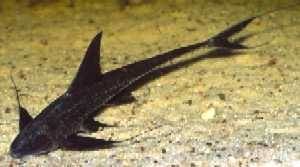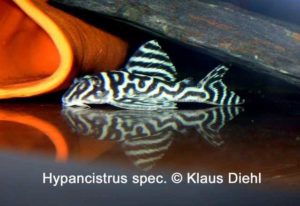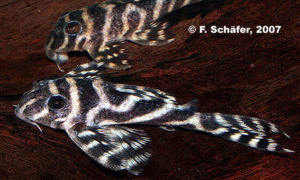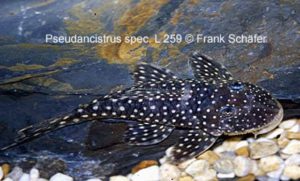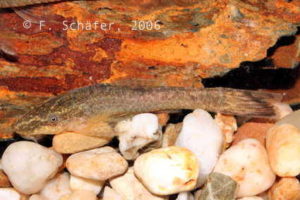From southern Brazil and northern Argentina originates the probably most beautiful representative of the genus Hypostomus. Contrary to many other loricariids they become more beautiful with increasing age, since the portion of the yellow body parts constantly increases. Their southern area of origin suggests a tolerance in relation to low temperatures. They can be can […]
10b. Catfishes: Suckermouths, Plecos and L-numbers (315)
-
-
Panaque spec. „New Royal Golden Thunder“
September 2006: This week we succeeded in importing several of this beautiful new Panaque from Brazil. In their appearance they remind of L 27, are however flatter and slimmer than these. In addition they possess a larger mouth and their dorsal fin is smaller. These characteristics let assume that they originate from strongly flowing river […]
-
Hypostomus sp. „Chaco“
A close relative of the well known common plecos, is shown at the time of the importation not fully grown yet. This fish can easily grow up to 30 cm in length. This pleco is a harmless solitude fish, very well suited for the cichlid aquarium. It is an animal who has a nocturnal way […]
-
Panaque spec. „Papa Ojo Chico“ L 90a
With L 90a we can offer at present one of the most beautiful Panaque species. Especially the extremely long, orange colored filaments of the caudal fin are remarkable. In addition, the discrete black markings on the noble-grey colored body let them appear very elegant. With the purchase of these fishes their final size (over 30cm) […]
-
Pseudohemiodon thorectes
This catfish coming from Bolivia, belongs to the smallest of his relatives, measuring 13 cm maximum. It is mostly getting imported by travelling aquarium hobbyists. Regarding the water condition this kind is rather adaptable, as guide values of up to 400 µS/cm and a pH-value of 7.6 were measured. Approx. 25°C are quite enough for […]
-
Ancistrinae spec. L 189
Several adult specimen of L 189 the wormline – Orinko catfish arrived with an import of L 257 Pseudolithoxus tigris. On this shown male, the odontodes on the head, breast and ventral fin are clearly visible, that absolutely states a belonging in the Pseudolithoxus group. Puberty is approximately reached at 7 cm, it’s end size […]
-
Hypancistrus spec. Xingu
From lower parts of the Rio Xingu we received very high-contrasted Hypancistrus spec. Xingu. In their appearance they arrange between L 333 and fishes of the L 66 group. But they are clearly more flattened and stretched than L 333. From L 66 and their relatives (e.g. L 236) they can be distinguished by the […]
-
Peckoltia. spec. L 134
From the Rio Jamanxim (Brazil) comes one of the most attractive members of the genus Peckoltia. L 134 is very variably marked: as well as individuals with stripes there are also specimens with large round spots on the body. It is not known whether this difference in colouration denotes sex, but in at least one […]
-
Pterosturiosoma microps
Pterosturiosoma microps is one of the regularly imported Loricariidae from Peru, although not in bigger quantities. Even though it is more impressing in colour by its soft black-grey, it can still arouse enthusiasm by its remarkable appearance and its impressive but graceful fins. But its steady nursing is not quite easy. Whereas the acclimatization probably […]
-
Hypancistrus spec. L 173
March 2005: Freshly arrived: Beautiful German breds of L 173. For the first time we can offer thereby more than a “handful” of these wonderful rare pieces. The large variability of their pattern is remarkable. The bluish glow is common in all the white of their fins. (Photo & Text K. Diehl)
-
Rineloricaria melini
As a further german bred rarity we can offer Rineloricaria melini at present. Our specimen of the probably most attractive Rineloricaria species have with 9 – 12 cm length already attained full growth and are of outstanding quality. Their origin is the area of the Rio Negro where they live in black water biotopes. Like […]
-
Hypancistrus spec. L 173 Bred
March 2007: Freshly arrived: Beautiful German breds of L 173. For the first time we can offer thereby more than a “handful” of these wonderful rare pieces. The large variability of their pattern is remarkable. The bluish glow is common in all the white of their fins. (Photo F. Schäfer, Text K. Diehl)
-
Pseudancistrus spec. L 259
Pseudancistrus spec. L 259 originates from the surrounding of the city Pimental at the Rio Tapajos. As all Pseudancistrus species the males of L 259 show a characteristic “beard” of Odontodes (dermal teeth) during the spawning season. Contrary to the popular Hypancistrus species L 259 are vegetarians. Therefore Zucchini, cucumbers and further vegetables should be […]
-
Hisonotus notatus
July 2006 From southeast Brazil we could import some rare pieces from the relationship of the popular Otocinclus species. In its homeland Hisonotus ornatus inhabits with weeds infested waters. It may not be kept too warm. 24°C probably represents the reasonable upper limit. The requirements for their maintenance do not differ from those of the […]
-
Rineloricaria sp. „Colombia“
A remarkable species which came in in one of our import from Colombia. These fishes also originate from the Rio Chacu in the northern tip of the country. Because of the many bristles of the male this species has been falsely determined as Rineloricaria latirostris. A comparison with the pictures (see Mergus Catfish Atlas Part […]





